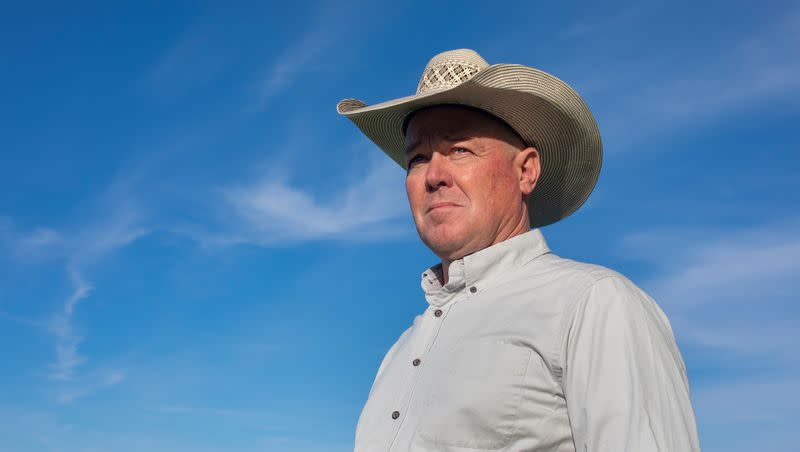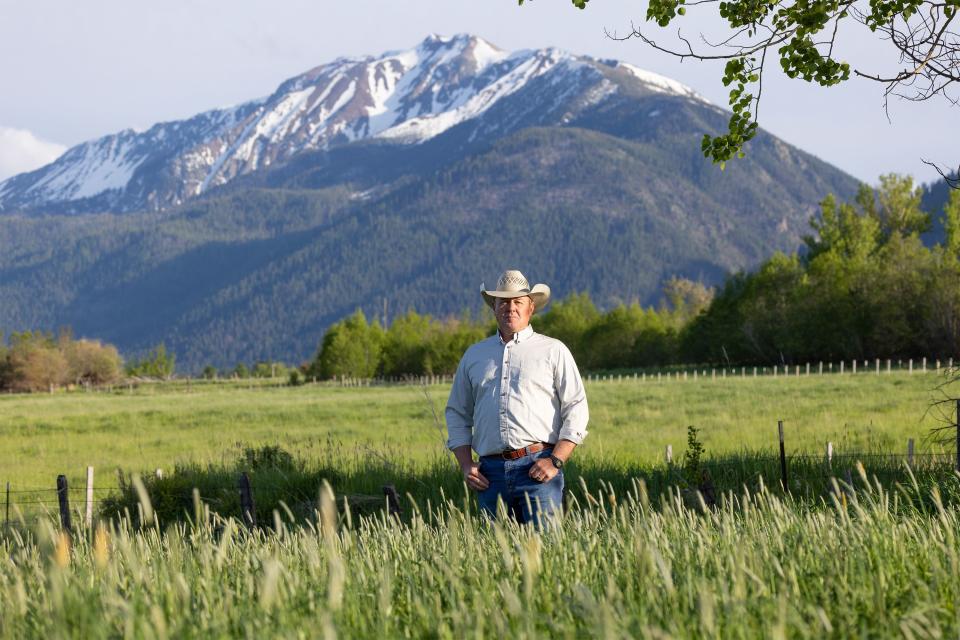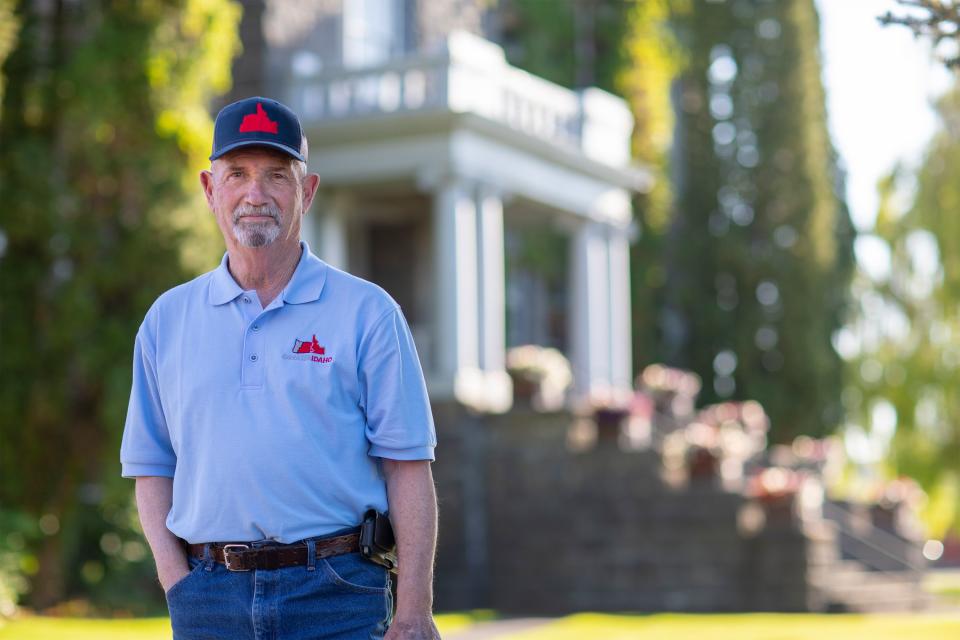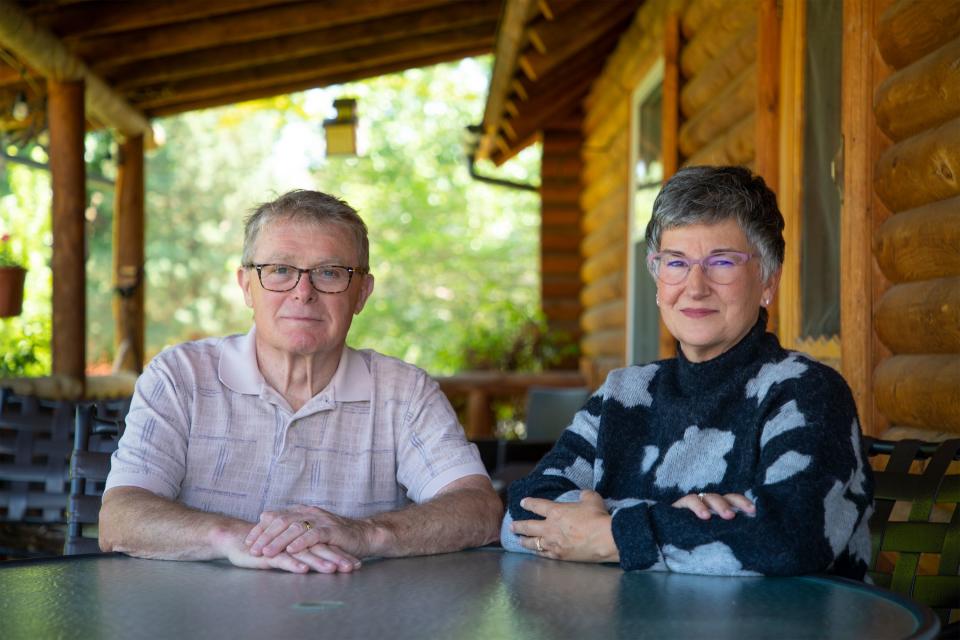The cost of a state line

On a clear day, Kevin McCadden can see the Seven Devils from his house on the slope at the edge of town. Rising to well over 9,000 feet, their snow-capped peaks stand guard over the rolling grasslands of Wallowa County — a visceral reminder of a century-old dividing line between here, Oregon, and there, Idaho.
Beyond the peaks lie the politics of Idaho — fewer regulations, lower taxes and conservative ideologies. But here, tucked away in the northeast corner of Oregon, near the town of Enterprise and far from the metropolitan grip of Portland, decades of rural resentment have made it easier to imagine that line shifting. Maybe, one day, McCadden might wake up in Idaho.
“There’s a lot of people that are really fed up, feeling like their voice isn’t heard,” he says, hoping someday, “we would have a government that’s representative of us.”
The sentiment is one that many share — that their rural communities have been forgotten, drowned out by the left-leaning urban hubs that drive the economic and legislative engines of a state with 70 percent of its population in the Willamette Valley. And over the past few years, talk of secession has gained steam.
McCadden, 61, a local science teacher, may know better, but Idaho is seemingly in reach. It’s only 35 miles as the crow flies from his living room window.
Between those peaks and that last bit of Oregon is a literal chasm. Where the Snake River grinds away at the Earth lies Hells Canyon, the deepest in the country, presenting a seemingly insurmountable crossing. An undeniable divide. A not-so-arbitrary place to draw a line.
Despite the analogous nature of this, some still think it’s possible to go the distance — to redraw the bounds of statehood — and embed eastern Oregon into a larger Idaho.
A “Greater Idaho.”
“Oregon has prided itself over the years for being the first to do certain things. Why can’t Oregon be the first to solve this rural-urban situation by adjusting the border?”
The ‘Greater Idaho’ movement
Twelve counties in Eastern Oregon have voted to begin commissioner-level talks to entertain the idea of creating “Greater Idaho.” Wallowa County became the 12th in May. It’s a symbolic vote — it by no means commits the counties or the state of Idaho. But it does highlight the will, or the discontent, of the people.
“We’re asking as free citizens, doing it the right way, doing it by the vote,” says Mike McCarter, the president of two Oregon secession organizations: Move Oregon’s Border and Citizens for Greater Idaho. “We’re doing everything legal and we’re just saying, we want to live where we live but we want to change who governs us.”
It’s one thing to get counties to vote on an idea, but it’s another trying to convince states to dive headfirst into a complicated, unprecedented and undoubtedly expensive rabbit hole. Early this year, the Idaho House of Representatives passed a memorial of their willingness to begin discussions with Oregon, but the measure stalled in the Senate. A similar one exists in Oregon’s legislature but has yet to receive much interest. It’s not just a question of whether Idaho can afford to accept these counties. It’s also a matter of asking: Are the people of eastern Oregon — and, to some degree, the taxpayers of Idaho — willing to accept less funding, fewer benefits and, for some, less equitable taxes in the name of like-minded neighbors?
“Moving a state border is not just drawing a line on a map,” says Norman Williams, the Ken and Claudia Peterson professor of law and director of the Center for Constitutional Government at Willamette University. “There are assets and liabilities that have to be transferred … and when you’re talking about two-thirds of the landmass of one of the largest states, geographically speaking, in the nation … that’s going to be measured in the billions of dollars.”
One thing advocates of succession have failed to consider is that of Native American sovereignty and the effect a border move would have on tribes in the area. It’s unclear how four Native American reservations — the Burns Paiute, the Confederated Tribes of the Umatilla, the Klamath Tribes, and the Paiute and Shoshone Tribes of Fort McDermitt — would be impacted if the land around their sovereign nations becomes Idaho. Although they receive funding from the federal government and are not subject to all state laws, there are symbolic implications for those whose land has been systematically stolen from them and questions of how such a move might benefit or harm them financially if the tribes have to renegotiate current agreements such as gaming practices or water rights.
Another, the Warm Springs Reservation, which is north of Bend, is on the proposed westernmost border. Those within the movement believe the tribe would have no interest in joining, but have not included them in conversations. “We perceive, based on the way they voted, that they wouldn’t necessarily want to be part of the state of Idaho,” says Matt McCaw, a spokesperson for the Greater Idaho movement. “But what we’ve come to realize is we’ve kind of made that assumption for them — we need to talk to these folks and find out their feelings on this.”

The conversations and fervor around ideology and representation have superseded practical implications and considerations. In more metaphorical terms, tires aren’t being kicked before putting rubber to the road. “There’s always a lot of questions. … What about driver’s licenses? Is Idaho going to have to pay money for Oregon’s land? Some of those things we can’t answer from our level, it’s got to be done at the government level,” McCarter says. “Oregon has prided itself over the years for being the first to do certain things like the bottle bill … the first to — even though I don’t agree with it — (decriminalize) hard drugs. Why can’t Oregon be the first to solve this rural-urban situation by adjusting the border?”
Yet the movement also underscores the worst parts of our country’s political hyperpartisanship and abhorrence to opposition rule — a staple of democracy — by harping upon the urban-rural divide. That narrative can lead to further galvanizing people into believing that the solution is political segregation. “We’ve seen a lot of state legislatures controlled by one party who seem entirely indifferent to meeting the needs of the minority in their state,” Williams says. “(But) we can’t just keep changing state lines every time some political minority feels like they would be better off in the state next door.”
Secession movements in America
Greater Idaho joins a long list of secession movements in American history. It may not be of the same ideology that calls for forming new states or complete separation, but it’s in a similar vein — where leaving is painted as the only option left. Texas has threatened to leave ever since it joined the Union. Half of Washington has mumbled about the State of Liberty for some time. The movement of “Cascadia” seeks to combine Oregon, Washington and parts of British Columbia. The list goes on.
“Like other movements in American history, it reflects both local grievances on the ground and larger political divisions in the nation at large,” says Richard Kreitner, a historian and author of “Break It Up: Secession, Division, and the Secret History of America’s Imperfect Union.” “The obstacles to success are quite high (but) unlike many others, I don’t think that means it’s impossible.”
“We can’t just keep changing state lines every time some political minority feels like they would be better off in the state next door.”
When it comes to actual examples of states moving their borders, history provides nothing of the same magnitude. West Virginia breaking away in the Civil War is the most famous example, but its use as a contemporary comparison is somewhat useless. Back then, the country was at war with itself, the government was much smaller, and the interconnectedness of institutions, agencies, and the private and public sectors was a far cry from today’s world.
One recent example does exist, however. North Carolina and South Carolina shifted their common border in 2017 to fix historical survey errors. The process moved the state line 50-100 feet in some places and took over two decades to complete. Ultimately, it hung in the legislative hinges because of — get this — a gas station that would have had its pumps moved to North Carolina, forcing it to adhere to higher premiums. A law was passed specifically for the gas station to continue selling at South Carolinian prices.
Moving a state border hundreds of miles is without precedent. Idaho and Oregon could be forced to reckon with an unknown number of similar situations as in the Carolinas, changing the fate of thousands of homes, schools, institutions and businesses.
“You’re fundamentally shaking up and spilling out new overlapping governments with different responsibilities. There’s the state government that would change, but are you in a county, are you in a town, are there special districts, are there school districts — (those all) require different taxes and require different spending,” says Richard Auxier, a senior policy associate at the Urban-Brookings Tax Policy Center, a nonpartisan think tank. “If you flip this switch, you would be flipping a lot of switches along with it.”
Economic impacts of a border move
In early 2023, a study was released by Points Consulting in Moscow, Idaho. The study, funded by the conservative think tank The Claremont Institute, offers the only analytical window into the potential economic implications of shifting the Idaho border to include 22 Oregonian counties. “The hardest adjustment would be people working the public sector … (and) people who are really, really low-income. You’re not going to be getting the same benefits that you were getting as a resident of Oregon,” Brian Points, the president of the consulting firm, says. “Just purely in terms of impact, there’s a lot of people who would be very positively impacted as well: business owners, entrepreneurs, farmers, manufacturing and transportation, those types of industries.”
Economically, Idaho brings less to the table. Its $84 billion gross domestic product is only a third of Oregon’s with just under half the population. Its state budget of $13.2 billion is $300 million less than Oregon’s recently proposed education budget alone. The counties for whom Idaho would be responsible, despite low population densities, come with high poverty levels, unemployment and lower economic output that requires extensive state subsidies that fund their infrastructure and welfare programs.
The Claremont study found that Idaho would need to subsidize the counties “to the tune of $78 million” (or $42 per Idahoan) a year, far from the $1.22 billion Oregon currently pays. Simply put, the counties which are heavily subsidized by higher income earners in the Willamette Valley would see about 94 percent of state funding disappear.

Shelley Wyllie and her husband Kelly recently joined fellow locals in voicing their opposition to Greater Idaho at a meeting in the Grant County courthouse, 33 miles away from their home in Dayville, Oregon. Dressed in matching T-shirts, the group of individuals — which Wyllie clarified is not an official group — argued that moving the border could harm residents. “We wanted our family, friends and community to be fully aware of the financial impact of moving the border,” she says. “Thirty percent of Oregonians qualify for Oregon’s Health Plan, but 35 percent of Grant County residents qualify for that service. … I don’t think people have any idea, and Idaho has no plan for that.”
Although some fluctuation is expected as pandemic-era extensions end, Idaho would see an influx of Medicaid enrollees by accepting Oregonian counties. Even just the 12 counties that voted in favor have 98,829 enrollees — that’s around one-quarter of Idaho’s current total Medicaid enrollment, which already costs the state over $1.2 billion. If all 22 Oregonian counties of the Greater Idaho movement were to join the state, Idaho’s Medicaid enrollment would almost double to over 700,000 enrollees. “The most logical conclusion would be that, well, you’re now in the state of Idaho so you play by these rules,” Points says. “So a lot of those people just aren’t eligible anymore.”
In a “Greater Idaho,” former Oregonians’ lofty minimum wage (which ranges between $13.20 and $15.45, depending on the county) would drop to $7.25 an hour. Idaho would also implement a 6 percent sales tax, costing the new residents around $706 million. Although not necessarily bad, Auxier explains that sales tax is regressive, equating a larger percentage of yearly income for poorer earners than wealthier individuals. “If you went from having no sales tax to having a sales tax, you would be shifting a larger burden of your overall tax burden onto lower-income residents,” he says. “If a lower income person just moved from Oregon to Idaho, their relative tax bill would go up.”
“We can’t just keep changing state lines every time some political minority feels like they would be better off in the state next door.”
Income taxes would also change for the seceding counties. The Claremont study found that Oregonians could pay less if they were living in Idaho, but Points clarifies that while Oregon taxes lower-income people more than Idaho does, they also “receive a lot more benefits as well.” In the end, “it’s not just a matter of what the changes in tax home income are, it’s also about the reduction in benefits, which can’t precisely be pinned down on a household income basis.”
When it comes to trade and industry, Idaho could have better outcomes for residents. But in recent years, Oregon’s economy has also been buoyed by the production of recreational marijuana, which is illegal in Idaho. One of the pro-Greater Idaho counties, Malheur, is one of the state’s biggest sellers, selling $2,900 worth of marijuana for each of its 31,000 residents every year. If Malheur were to suddenly find itself in Idaho, the legislature — which has been reluctant to legalize cannabis — would need to decide whether to allow production in some counties or shutter businesses and abandon tax revenue on the county’s $100 million industry. “I don’t know how you get that genie back in the bottle,” Points says. “Seems like a problematic situation.”
Will Eastern Oregon be heard?
Back in Wallowa County, a group of locals can be found eating breakfast at the Cheyenne Cafe in downtown Joseph. It doesn’t take much for the conversation to snake to moving the state line. Most agreed on one thing: that nobody is listening to rural concerns and that voting for a “Greater Idaho” might be enough to get politicians to start paying attention.
McCadden says he voted for the measure hoping for more discussion. He doesn’t want to be represented by politicians who don’t share his values. When he sees issues such as homelessness, drug use and protests coming out of Portland, he can’t help but look toward Idaho and see more common ground. Even the Wyllies, who vehemently oppose a “Greater Idaho,” agree that something must be done. “The core issue is getting the residents of Eastern Oregon to be heard,” Shelley Wyllie says, believing a community collaboration project may be the answer. “Oregon has led on so many different things nationally. … I would like to see us lead on this collaboration because we’re not the only conservative place in the United States having these issues.”

Meanwhile, about 300 miles away near Mount Hood, conservatives met at the Dorchester Conference in late April. Along with social gatherings and guest speakers situated on a golf resort, Republican Party members, including legislators, gathered to cast their vote on the Greater Idaho movement. Another symbolic signaling event for overall interest, it was an important one largely because the movement’s success will eventually be completely dependent on the interest of politicians to support them through the halls of their legislature.
They voted “no.”
Correction: An earlier version of this story incorrectly stated that Malheur County is one of Oregon’s biggest producers of marijuana. The county is one of the biggest sellers of marijuana in the state.
This story appears in the July/August issue of Deseret Magazine. Learn more about how to subscribe.

